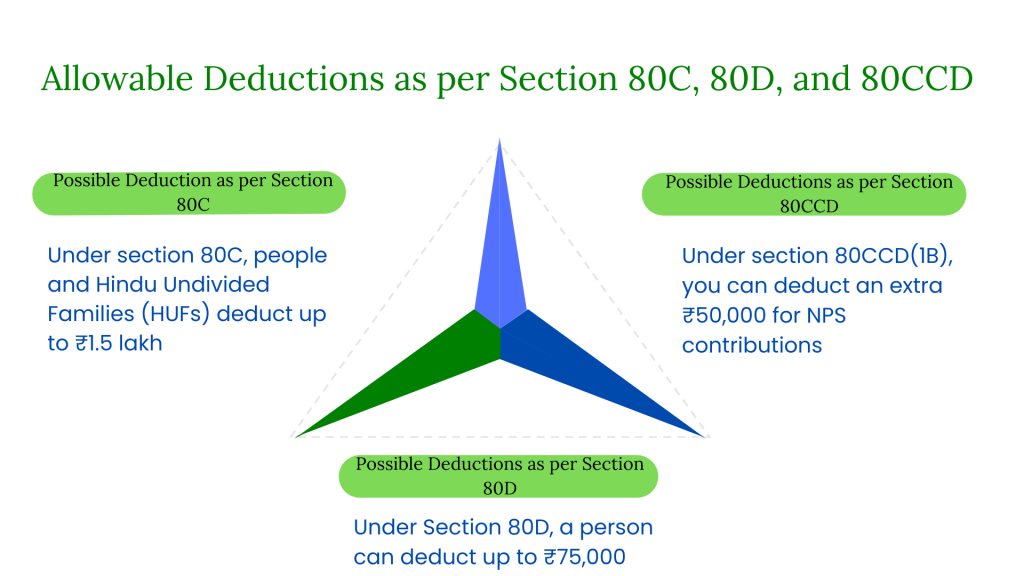Tax Deductions as per Sections 80C, 80D, and 80CCD
In India, it’s very important to keep track of tax payments well to save the most money. Different parts of the Income Tax Act let people lower their taxable income by investing in certain financial goods. Sections 80C, 80D, and 80CCD hold utmost importance for taxpayers as these sections help in saving a lot of taxes by reducing taxable income. This discusses the income tax deductions available under various sections such as 80C, 80D, & 80CCD. It will also talk about the best ways to invest and tax Savings.

A Quick Look at Section 80C
A lot of people use Section 80C of the Income Tax Act to save money on their taxes. This rule lets people and Hindu Undivided Families (HUFs) deduct up to ₹1.5 lakh from their income in a financial year if they invest in the following things:
Investments As per Section 80C
Some of the most popular investments that can be written off under Section 80C:
- The Public Provident Fund (PPF) lets people save money for the future. The money is locked in for 15 years and earns 7.1% per year. The interest that has built up is not taxed.
- The National Savings Certificate (NSC) is a fixed-return investment that gives a guaranteed return of 6.8% per year for five years. The interest that builds up is taxed.
- Equity Linked Savings Scheme (ELSS) is a type of mutual fund that locks in your money for three years. The returns change with the market and are not set.
- Life Insurance Premiums: You can reduce the premiums you pay for life insurance.
- The Sukanya Samriddhi Yojana (SSY) is a way for girls to save money. It has a high interest rate of 7.6% per year and the money can’t be taken out until the girl is 21 or gets married.
- Senior Citizen Savings Scheme (SCSS): This plan offers a five-year lock-in interest rate of about 8.2% per year to people over the age of 60.
- Fixed deposits that save you money on taxes: These are locked in for five years and pay interest rates between 5.5% and 7.75%. It is taxed on the interest.
Advantages of Section 80C
Putting money into Section 80C not only lowers your taxed income but also helps you save money in a planned way. Most of these investments, like PPF and NSC, offer promised returns, which makes them good for investors who like to be safe. ELSS investments put you in the stock market, which could give you better returns in the long run.
Understanding Section 80D
People can deduct the cost of their health insurance payments under Section 80D of the Income Tax Act. This part is meant to encourage people to get health insurance so that they are financially protected in case of a medical emergency.
Allowable Income Tax Deductions As per Section 80D
- Self and Family: People can deduct up to ₹25,000 in health insurance premiums paid for themselves, their spouses, and their children who rely on them.
- Parents: You can claim an extra ₹25,000 for your parents’ premiums. If the parents are over 60, this amount goes up to ₹50,000.
- Deduction: Under Section 80D, a person can deduct up to ₹75,000, and they can deduct up to ₹100,000 if their parents are senior citizens.
Advantages of Section 80D
Buying medical insurance not only protects you financially from the high cost of medical care, but it can also help you save money on taxes. With healthcare costs going up, it’s important to make sure you have enough medical insurance to protect your finances.
Section 80CCD
For purchases in pension plans like the National Pension System (NPS) and the Atal Pension Yojana, Section 80CCD is just what you need. Investors in pension funds are more likely to save for retirement because of this.
Possible Income Tax Deductions As per Section 80CCD
- Part 80CCD (1): This part of the law lets employers subtract the money their employees put into the NPS and other plans listed in it. People who are salaried can only deduct 10% of their basic pay plus the dearness allowance, and people who are self-employed can only deduct 20% of their gross total income. However, Section 80CCE sets a maximum reduction of ₹1.5 lakh.
- Section 80CCD(1B): More than the ₹1.5 lakh exemption cap in Section 80CCE, this section lets you deduct an extra ₹50,000 for NPS contributions.
- Section 80CCD(2): lets employers deduct NPS contributions that are more than the ₹1.5 lakh cap set by Section 80CCE. For most employers, the deduction is limited to 10% of basic pay and dearness income. For central government employers, it is 14%.
Advantages of Investing in Section 80CCD
Investing under Section 80CCD helps build a nest egg for retirement and also gives tax breaks. The NPS, in particular, has a systematic way of planning for retirement, and members can choose from several different investment choices.
Get Started with TaxDunia
Putting money into investments under Sections 80C, 80D, and 80CCD can help lower taxed income and make sure you have enough money for savings and insurance. If you know which investments and deductions are allowed under each part, you can make a plan to save money on taxes overall. Whether someone wants to save for retirement, get health insurance, or invest in fixed-income securities, these areas give them a lot of choices to meet their different financial needs and goals. People can get the most out of their tax savings and build long-term financial safety by planning and investing at the right time. Let TaxDunia optimize your taxes and reduce the taxable income under the provisions available in Income Tax Acts. Our team of dedicated professionals will handle your taxes and communicate to the tax authorities on your behalf.

